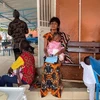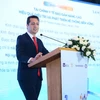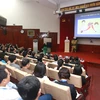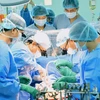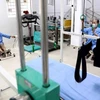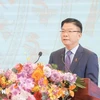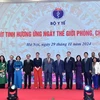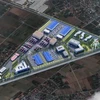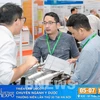Paediatrics Hospital No 1 in Ho Chi Minh City has become the first hospital in the country to successfully apply the techniques of reducing body temperature to cure a choking newborn.
"It is a great success for medicine in this country as choking is one of the three leading causes of fatalities and after-effects in newborns," said the head of the hospital's Newborn Recovery Ward, Cam Ngoc Phuong.
In Vietnam , about 3-5 live births per 1,000 suffer from choking, which cuts off oxygen to the victims' brains, leading to epilepsy and cerebral palsy, she said. The global rate is 2 per 1,000 live births.
The newborn can chokie if the mother begins labour too late or too fast, the foetus's position is unnormal, the labour lasts too long or the delivery is difficult, said Phuong.
Before, victims can receive supportive treatment such as oxygen, heart and lung medications and convulsion-prevention medicines.
"The treatment can prevent injuries to the heart, liver and kidneys, but it cannot improve wounds in brain," said Phuong.
The technique of reducing the newborn's body temperature has been applied in the US and Europe since 2002, she noted. This year, the hospital assigned two doctors to study the technique in Denmark .
With the technique, doctors use special equipment to reduce the newborn's temperature to 33-34 degree Celsius within 72 hours to decrease the number of brain cells being damaged by the lack of oxygen and prevent injuries caused by brain oedema.
"It is not complicated to apply the technique, but the most important thing is supervising the baby's condition during the treatment period," Phuong said.
The only difficulty in the technique is that the expense for the machine of reducing the body temperature is high, she added.
Ho Tan Thanh Binh, a doctor in the ward, said the first baby in the country to receive the technique was a 3.6kg girl born by caesarian section in February. After the delivery, the baby lost consciousness.
After being treated with the technique, she recovered and was discharged from hospital when she was 12 days old, said Binh.
So far, seven newborns have received the technique, and were discharged from the hospital in stable condition.
"The technique should be applied for newborns under six hours old," Binh said.
After being discharged from the hospital, the newborn should be re-checked every four or six months and receive physical therapy for the best results, he said.
Phuong noted that the treatment costs the patient's family about 2 million VND (100 USD). "The price is much cheaper than that in foreign countries as we cover the costs of the equipment only, while other countries factor in costs of beds and services" said Phuong.
Doctors from the hospital have presented the technique in seminars in HCM City and provinces in the central region in the hopes of expanding the technique all over the country.
"If any hospital in the country wants to apply the method, we are ready to assign a doctor and nurse to guide them," said Phuong.
Meanwhile, Nguyen Thu Trang, a doctor from the National Paediatrics Hospital in Hanoi lauded the technique.
"But the costs of the equipment is high and the hospital needs support from medical organisations to buy it," Trang said.-VNA
"It is a great success for medicine in this country as choking is one of the three leading causes of fatalities and after-effects in newborns," said the head of the hospital's Newborn Recovery Ward, Cam Ngoc Phuong.
In Vietnam , about 3-5 live births per 1,000 suffer from choking, which cuts off oxygen to the victims' brains, leading to epilepsy and cerebral palsy, she said. The global rate is 2 per 1,000 live births.
The newborn can chokie if the mother begins labour too late or too fast, the foetus's position is unnormal, the labour lasts too long or the delivery is difficult, said Phuong.
Before, victims can receive supportive treatment such as oxygen, heart and lung medications and convulsion-prevention medicines.
"The treatment can prevent injuries to the heart, liver and kidneys, but it cannot improve wounds in brain," said Phuong.
The technique of reducing the newborn's body temperature has been applied in the US and Europe since 2002, she noted. This year, the hospital assigned two doctors to study the technique in Denmark .
With the technique, doctors use special equipment to reduce the newborn's temperature to 33-34 degree Celsius within 72 hours to decrease the number of brain cells being damaged by the lack of oxygen and prevent injuries caused by brain oedema.
"It is not complicated to apply the technique, but the most important thing is supervising the baby's condition during the treatment period," Phuong said.
The only difficulty in the technique is that the expense for the machine of reducing the body temperature is high, she added.
Ho Tan Thanh Binh, a doctor in the ward, said the first baby in the country to receive the technique was a 3.6kg girl born by caesarian section in February. After the delivery, the baby lost consciousness.
After being treated with the technique, she recovered and was discharged from hospital when she was 12 days old, said Binh.
So far, seven newborns have received the technique, and were discharged from the hospital in stable condition.
"The technique should be applied for newborns under six hours old," Binh said.
After being discharged from the hospital, the newborn should be re-checked every four or six months and receive physical therapy for the best results, he said.
Phuong noted that the treatment costs the patient's family about 2 million VND (100 USD). "The price is much cheaper than that in foreign countries as we cover the costs of the equipment only, while other countries factor in costs of beds and services" said Phuong.
Doctors from the hospital have presented the technique in seminars in HCM City and provinces in the central region in the hopes of expanding the technique all over the country.
"If any hospital in the country wants to apply the method, we are ready to assign a doctor and nurse to guide them," said Phuong.
Meanwhile, Nguyen Thu Trang, a doctor from the National Paediatrics Hospital in Hanoi lauded the technique.
"But the costs of the equipment is high and the hospital needs support from medical organisations to buy it," Trang said.-VNA
